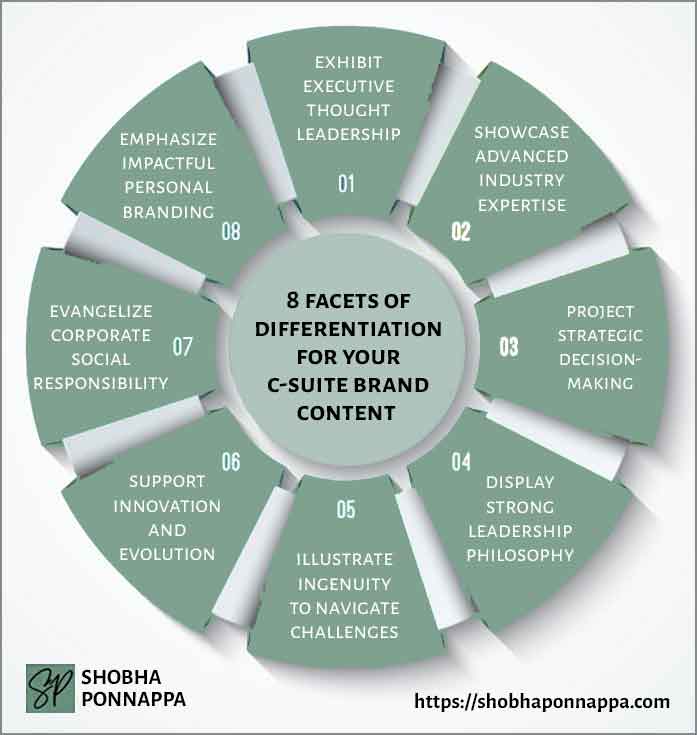
In the world of C-Suite branding, ordinary won’t cut it. To truly excel, C-Suite leaders must embrace an unconventional approach to content marketing.
Discover how to break free from the mundane, captivate your audience, and elevate your brand to extraordinary heights.
Welcome to “The Ultimate Guide To Unusual C-Suite Brand Content Marketing.” In this comprehensive guide, we delve into innovative strategies designed exclusively for C-Suite brands.
Buckle up as we unravel the secrets of content marketing that defies the norm and empowers C-Suite brands to stand out in a competitive digital landscape.
In today’s fiercely competitive business landscape, C-Suite brands are faced with the challenge of breaking free from the ordinary. Conventional content marketing strategies often blend into the digital noise, leaving executive brands struggling to distinguish themselves.
This is where the importance of uncommon content marketing becomes evident. Uncommon content marketing doesn’t follow the traditional playbook; it thrives on creativity, innovation, and the unexpected. By daring to be different, C-Suite brands can captivate their audience’s attention in a way that conventional methods simply cannot.
Uncommon content marketing allows these brands to craft narratives that resonate deeply with their target audience, building stronger connections and fostering trust. Moreover, in an era where authenticity and uniqueness are highly prized, uncommon content marketing sets C-Suite brands apart as trailblazers in their respective industries.
It enables them to share their visionary insights, engage with stakeholders, and leave a lasting impression in the minds of their audience. This article explores the compelling reasons why C-Suite brands need to embrace the power of uncommon content marketing to stand out, connect, and thrive in the ever-evolving business landscape.
Drawing upon my experience as a seasoned Brand Content Strategist known for crafting content that defies convention, I invite you to explore eight ingenious strategies. These tactics are designed to inject a fresh perspective into your C-Suite brand’s content approach.
Step away from the ordinary, and let’s lay the foundation for a truly unique online presence. Embrace the unexpected, shatter the norm, and emerge as a beacon of originality in an increasingly homogeneous digital landscape.

Exhibiting executive thought leadership is an essential facet of distinctive C-Suite brand content marketing. It transcends the commonplace and demands a visionary approach. Imagine a scenario where a CEO, let’s call her Sarah, spearheads a tech company.
Rather than merely endorsing her products, Sarah delves deep into the intricacies of emerging technologies. Her thought leadership shines as she pens articles and hosts webinars exploring the potential ethical dilemmas of AI or the future implications of blockchain in the industry.
This approach not only showcases her expertise but also sparks engaging discussions within her niche. It positions her as an authority, not just a promoter. Thought leadership content should aim to challenge existing paradigms, inspire meaningful dialogue, and offer unique insights that resonate with the audience.
It’s about guiding the industry’s narrative and, in the process, setting the brand apart as an innovative, forward-thinking entity. By demonstrating genuine expertise and vision, C-Suite brands can elevate themselves above the ordinary and create a lasting impact in the digital sphere.
Displaying advanced industry expertise is a key element in crafting remarkable C-Suite brand content. It transcends the ordinary, demanding a profound understanding of the industry’s intricacies.
Picture a scenario where a Chief Financial Officer, let’s call him Alex, leads a financial services corporation. Instead of merely discussing financial metrics, Alex takes a deep dive into the intricate world of risk management. Through a series of webinars and articles, he explores the nuances of assessing market risks and offers practical strategies for mitigating them.
This approach positions Alex as an authoritative figure, not just within the company but also in the broader industry. Showcasing advanced industry expertise requires a commitment to continuous learning and staying updated with the latest trends and developments.
It’s about offering a unique perspective that enriches the discourse within your niche and solidifies your brand’s standing as an expert resource. By demonstrating your command of complex industry topics, you can set your C-Suite brand on a path of distinction and recognition in the digital landscape.
Demonstrating the art of strategic decision-making is a pivotal component of crafting standout C-Suite brand content. It transcends the commonplace, demanding a transparent and visionary approach. Let’s consider a scenario where a Chief Marketing Officer, we’ll call her Lisa, leads a global consumer goods company.
Instead of merely showcasing successful marketing campaigns, Lisa takes her audience on a journey through the pivotal decisions that led to those successes. In a series of engaging video narratives and blog posts, she dives into the intricacies of market research, data-driven insights, and innovative marketing strategies that guided her team’s choices.
This approach not only positions Lisa as a masterful decision-maker but also offers her audience an opportunity to learn from her experiences. Projecting strategic decision-making involves openly discussing the rationale behind critical choices, the potential risks involved, and the lessons learned along the way.
It’s about inspiring trust, transparency, and admiration among peers and followers, reinforcing your brand as a beacon of strategic acumen within your industry.
Revealing a robust leadership philosophy is a fundamental element of crafting remarkable C-Suite brand content. It transcends the ordinary, necessitating a clear and authentic approach to leadership.
Let’s envision a scenario where a Chief Sustainability Officer, known as Alex, leads a global tech conglomerate. Beyond highlighting corporate sustainability efforts, Alex consistently shares content that elucidates the ethical principles and sustainability values guiding every business decision.
Through compelling articles and engaging social media narratives, Alex delves into the moral imperative of environmental responsibility and the broader vision of contributing to a better world. This approach not only positions Alex as a principled leader but also invites the audience to connect with the brand on a deeper level.
Displaying a strong leadership philosophy involves openly articulating core values, ethics, and the commitment to making a positive impact. It’s about fostering trust, aligning with like-minded individuals and organizations, and establishing your brand as a beacon of purpose-driven leadership within your industry.
Demonstrating ingenuity in navigating challenges is a hallmark of exceptional C-Suite brand content marketing. It transcends the ordinary and demands a creative and inventive approach to problem-solving.
Imagine a scenario where a Chief Technology Officer, let’s call her Mark, leads a software company facing a competitive market. Instead of simply discussing the challenges they encounter, Mark crafts engaging content that dives into the innovative strategies and unique technological solutions they’ve employed to overcome these obstacles.
Through informative blog posts and captivating videos, Mark shares insights into groundbreaking software development methodologies, such as leveraging AI for enhanced user experiences. This approach positions Mark as a tech visionary, not just a corporate figurehead.
Illustrating ingenuity involves showcasing your ability to think outside the box, adapt to changing circumstances, and drive your brand forward with creative problem-solving. It’s about inspiring your audience to embrace innovation and view challenges as opportunities for growth. By doing so, your C-Suite brand can shine as a beacon of ingenuity in a competitive digital landscape.
Fostering an environment that supports innovation and evolution is pivotal in the realm of extraordinary C-Suite brand content marketing. It goes beyond the ordinary, demanding a commitment to staying at the forefront of industry advancements and inspiring others to do the same.
Imagine a scenario where a Chief Innovation Officer, let’s call her Rachel, leads a forward-thinking technology conglomerate. Rather than just showcasing the latest products, Rachel consistently shares content that explores the company’s innovation journey, from initial concepts to groundbreaking technologies.
Through insightful blog posts and captivating webinars, Rachel offers glimpses into the company’s research labs, showcasing experiments that didn’t just push boundaries but obliterated them. This approach positions Rachel and her brand as pioneers, not just market players.
Supporting innovation and evolution involves not only championing your own groundbreaking initiatives but also nurturing an ecosystem where curiosity and exploration are celebrated. It’s about inspiring your audience, peers, and the industry at large to embrace change and drive innovation forward. By doing so, your C-Suite brand can shine as a catalyst for progress in an ever-evolving digital landscape.
Championing the cause of corporate social responsibility (CSR) is an integral facet of exceptional C-Suite brand content marketing. It transcends the commonplace, requiring a genuine commitment to making a positive impact on society. Consider a scenario where a Chief Sustainability Officer, let’s call her Emily, leads a global energy corporation.
Beyond reporting sustainability metrics, Emily consistently shares content that delves into the tangible ways her company is reducing its carbon footprint. Through compelling narratives, thought-provoking videos, and interactive sustainability reports, Emily showcases initiatives like transitioning to renewable energy sources, reducing waste, and actively contributing to environmental conservation.
This approach positions Emily as a passionate advocate for CSR, not just an executive figurehead. Evangelizing corporate social responsibility involves authentically demonstrating your brand’s dedication to ethical practices and making a meaningful difference in the world.
It’s about inspiring others to follow suit, fostering a sense of shared responsibility, and solidifying your brand as a leader in ethical corporate practices. By doing so, your C-Suite brand can shine as a beacon of purpose-driven leadership in an increasingly conscious and interconnected digital landscape.
Spotlighting the significance of impactful personal branding is a pivotal element of exceptional C-Suite brand content marketing. It transcends the mundane, demanding a strategic approach to crafting and conveying a personal brand identity.
Let’s envision a scenario where a Chief Financial Officer, we’ll call him Daniel, leads a financial consultancy firm. Rather than solely focusing on corporate finance topics, Daniel consistently shares content that centers on his personal journey, leadership principles, and his commitment to financial literacy.
Through engaging storytelling, video interviews, and keynote presentations, Daniel connects with his audience on a personal level, offering valuable insights that extend beyond his role as CFO. This approach not only positions Daniel as an influential figure but also invites his audience to resonate with the brand on a profound level.
Emphasizing impactful personal branding is about crafting a compelling narrative that reflects your core values, expertise, and vision. It’s about inspiring trust, building a loyal following, and establishing your brand as a paragon of authentic leadership within your industry.

"As a Content/Brand Specialist, and SEO/UX Writer, I can help transform your brand's online presence. I can lift it with innovative ideas to take it to an enviable position. Let's collaborate to create a captivating brand story, engage your audience, boost your online visibility, and increase your ROI. Take the next step towards your brand content success and contact me today."
Shobha Ponnappa
I Bring You:
Content Marketing That’s “Unusual By Strategy” … Tips, Tricks, Tactics, Techniques, Trends, Training.
Get my weekly ContenTracker Newsletter packed with loads of content marketing ideas – proven and unusual.
Get a free download of my ebook on “50 Unusual Ways To Use AI In Content Marketing” … and transform your success.

Just fill in the form to join my community … we have big and small brands for company. You’ll stay on the speedway to growth.
KEY TOPIC CATEGORIES COVERED ON THIS SITE:
COPYRIGHT © 2024. SHOBHAPONNAPPA.COM. ALL RIGHTS RESERVED.

Just fill in this form and get this awesome ebook in your email inbox. Plus … each week you’ll receive my ContenTracker Newsletter that brings you tips, tricks, tactics, techniques, trends, and training on the latest in content marketing.